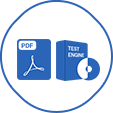Last Update 20 hours ago Total Questions : 230
The MCCQE Part 1 Exam content is now fully updated, with all current exam questions added 20 hours ago. Deciding to include MCCQE practice exam questions in your study plan goes far beyond basic test preparation.
You'll find that our MCCQE exam questions frequently feature detailed scenarios and practical problem-solving exercises that directly mirror industry challenges. Engaging with these MCCQE sample sets allows you to effectively manage your time and pace yourself, giving you the ability to finish any MCCQE Part 1 Exam practice test comfortably within the allotted time.
A 21-year-old man presents to the Emergency Department with a 6-month history of unusual behavior. He believes that he has been specially chosen to found a new religion. He says he has seen visions of angels in his bedroom. He appears disheveled and malodorous. On further inspection, you note that he drinks 2 liters daily. Which one of the following is the most appropriate initial management?
You are treating a 78-year-old man for recent onset of diarrhea, tenesmus, and minor bleeding when he wipes. He has a history of prostate cancer that was treated by radiotherapy. Rectal examination findings are normal. Colonoscopy reveals a pale rectum with ulcerations and areas of mucosal hemorrhage. Which one of the following is the most likely explanation for this clinical presentation?
A 35-year-old woman presents to your clinic for follow-up regarding her persistent primary immune thrombocytopenic purpura. She was admitted to hospital with a relapse and received treatment with dexamethasone, intravenous immunoglobulin, and rituximab. She was recently discharged from hospital with a platelet count of 55 × 10⁹/L (130–360), and also continues to take 10 mg of prednisone once daily. She is scheduled for a splenectomy in 4 weeks. Which one of the following is the best next step in preparation for the patient's surgical procedure?
A 23-year-old woman with borderline personality disorder is brought to the Emergency Department having ingested non-lethal substances after her boyfriend broke up with her. The staff tells you that she has consulted 8 times under similar circumstances in the past 3 years. Which one of the following pieces of information would be useful to provide to the staff?
You are called to attend an 18-year-old woman, gravida 2, para 1, aborta 0, who is in precipitous labour. She did not realize she was pregnant and has not had any prenatal care. After the delivery, you examine the newborn boy; he is vigorous, and it appears that he was born at full term. Physical examination findings of the newborn are normal. Review of the prenatal record from the mother's last pregnancy shows the following:
HIV: Negative
Hepatitis B surface antibody: Positive
Hepatitis C: Negative
Syphilis serology: Negative
The mother's previous child was placed in foster care. The mother is withdrawn and uncommunicative after delivery. Which one of the following is the best next step?
A 55-year-old man with alcohol use disorder presents with a 2-day history of confusion. Onexamination, you note a sixth nerve palsy and a horizontal nystagmus. Which one of the following is the most likely diagnosis?
A 70-year-old woman had a total abdominal hysterectomy with bilateral salpingo-oophorectomy 2 days ago. On examination today, her vital signs are as follows: She has been immobile since her operation. She is fatigued but is tolerating a full diet. Which one of the following is the most likely cause of this patient's fever?

